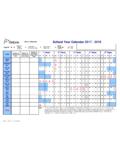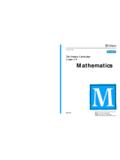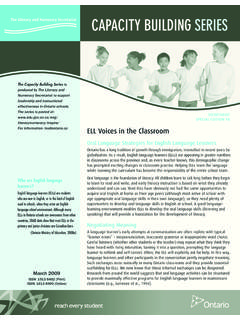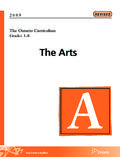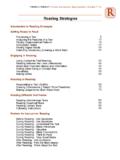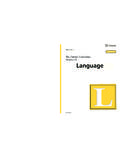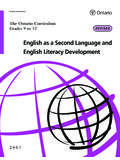Transcription of Ontario Curriculum Grades 11 and 12, Native Studies
1 Ministry of EducationThe Ontario CurriculumGrades 11 and 12 Native Studies2000 ContentsUne publication quivalente est disponible en fran ais sous le titre suivant : Le Curriculum de l Ontario , 11eet 12eann e tudes autochtones, publication is available on the Ministry of Education swebsite at ..3 The Place of Native Studies in the Curriculum ..3 The Program in Native Studies ..4 Overview ..4 Teaching Approaches ..6 Curriculum Expectations ..6 Strands ..7 CoursesEnglish: Contemporary Aboriginal Voices, Grade 11, University Preparation (NBE3U) ..9 Current Aboriginal Issues in Canada, Grade 11, University/College Preparation (NDA3M) .. 19 Aboriginal Beliefs, Values,and Aspirations in Contemporary Society, Grade 11, College Preparation (NBV3C).
2 28 English: Contemporary Aboriginal Voices, Grade 11, College Preparation (NBE3C) .. 37 Aboriginal Beliefs, Values,and Aspirations in Contemporary Society, Grade 11,Workplace Preparation (NBV3E) .. 47 English: Contemporary Aboriginal Voices, Grade 11,Workplace Preparation (NBE3E) .. 56 Aboriginal Governance: Emerging Directions, Grade 12, University/College Preparation (NDG4M) .. 64 Issues of Indigenous Peoples in a Global Context, Grade 12, University/College Preparation (NDW4M) .. 72 Some Considerations for Program Planning in Native Studies .. 80 The Achievement Chart for Native Studies .. 823 IntroductionThe Ontario Curriculum , Grades 11 and 12: Native Studies , 2000will be implemented inOntario secondary schools starting in September 2001 for students in Grade 11 and inSeptember 2002 for students in Grade 12.
3 This document replaces People of Native Ancestry,Senior Division, document is designed for use in conjunction with The Ontario Curriculum , Grades 9 to 12:Program Planning and Assessment, 2000, which contains information relevant to all disciplinesrepresented in the Curriculum . The planning and assessment document is available both inprint and on the ministry s website at Place of Native Studies in the CurriculumNative Studies provides students in Ontario schools with a broad range of knowledge relatedto Aboriginal peoples to help them better understand Aboriginal issues of public interest dis-cussed at the local, regional, and national levels. Students will develop the skills necessary todiscuss issues and participate in public affairs.
4 Through their involvement in Native Studies ,they will increase their awareness and understanding of the history, cultures, world views, andcontributions of Aboriginal peoples in Canada. The program will also provide students withopportunities to enhance the problem-solving and critical-thinking skills that they will requirein postsecondary education, the world of work, and their roles as active its very nature, Native Studies is integrative. For example, when students examine the termsof a treaty negotiated by an Aboriginal nation with the Crown, they are combining bothNative Studies and history. When they use the works of Aboriginal writers to study the themeof renewal, they are combining Native Studies and English. Similarly, when they use multimediaresources to create art forms about contemporary Aboriginal issues, they are combining Nativestudies with matter from any course in Native Studies can be combined with subject matter fromone or more courses in other disciplines to create an interdisciplinary course.
5 The policies andprocedures regarding the development of interdisciplinary courses are outlined in the interdis-ciplinary Studies Curriculum policy Native Studies courses in Grades 9 and 10, students examine the cultures and post-1900 his-tory of Aboriginal peoples in Canada. These courses lay the foundation for the Native studiescourses in Grades 11 and 12. The courses outlined in this document provide broader and deeperexplorations of twentieth-century issues concerning Aboriginal peoples and Canadian diversity of cultural, linguistic, racial, and religious groups is a valuable characteristic ofCanadian society, and schools can help prepare all students to live harmoniously in a multi-cultural society in the interdependent world of the twenty-first is the land of origin for Aboriginal peoples, and the history of Canada begins withthem.
6 As the first people of Canada, Aboriginal peoples are unique in Canada s mosaic. Thus,exploration of the development and contributions of Aboriginal societies is central to anunderstanding of the social fabric of this program in Native Studies comprises courses offered in Grades 9 to 12. Two Native studiescourses are offered in Grades 9 and 10. The Curriculum expectations for these courses are pro-vided in The Ontario Curriculum , Grades 9 and 10: Native Studies , 1999. The Grade 9 course,Expressing Aboriginal Cultures, provides an overview of the various art forms used byAboriginal peoples to communicate information about Aboriginal cultures. The Grade 10course, Aboriginal Peoples in Canada, highlights twentieth-century history and contemporaryissues from an Aboriginal Native Studies courses are offered in Grades 11 and 12 six in Grade 11 and two inGrade 12.
7 This document contains the Curriculum expectations for these courses. In theGrade 11 courses, students focus on how various Aboriginal peoples define themselves andtheir communities, and on their visions of the future. In the Grade 12 courses, studentsexamine political, social, economic, and cultural issues relevant to Aboriginal peoples both in Canada and in the rest of the outlined in The Ontario Curriculum , Grades 9 to 12: Program Planning and Assessment, 2000,the new Curriculum for secondary school is organized into several types of courses. (See thedocument mentioned for a description of the different types of secondary school courses.)However, not all types of courses are available in every discipline. In the Native Studies programin Grades 11 and 12, four types of courses are offered: university preparation, university/collegepreparation, college preparation, and workplace in Native Studies , Grades 11 and 12 CourseGrade Course NameCourse Type CodePrerequisite11 English.
8 Contemporary UniversityNBE3 UGrade 10 English, AcademicAboriginal Voices11 Current Aboriginal Issues University/NDA3 MGrade 10 Aboriginal Peoples in Canada,in CanadaCollegeOpen, or Grade 10 Canadian History inthe Twentieth Century, Academic orApplied11 Aboriginal Beliefs, Values, CollegeNBV3 CGrade 10 Aboriginal Peoples in Canada, and Aspirations in Open, or Grade 10 Canadian History inContemporary Societythe Twentieth Century, Academic orApplied11 English: Contemporary CollegeNBE3 CGrade 10 English, Academic or AppliedAboriginal Voices11 Aboriginal Beliefs, Values, WorkplaceNBV3 EGrade 10 Aboriginal Peoples in Canada,and Aspirations in Open, or Grade 10 Canadian History inContemporary Societythe Twentieth Century, Academic orAppliedThe Program in Native Studies5 THE PROGRAM IN Native STUDIESC ourseGrade Course NameCourse Type CodePrerequisite11 English: Contemporary WorkplaceNBE3 EGrade 10 English, Academic or AppliedAboriginal Voices12 Aboriginal Governance.
9 University/NDG4 MAny Grade 11 university, university/ Emerging DirectionsCollegecollege, or college preparation course inNative studies12 Issues of IndigenousUniversity/NDW4M Any Grade 11 university, university/Peoples in aCollegecollege, or college preparation course inGlobal ContextNative studiesNote:Each of the courses listed above is worth one Chart for Native StudiesThis chart maps out all the courses in the discipline and shows the links between courses and the possible prerequisites for them. It does not attempt to depict all possible movements from course to Aboriginal CulturesGrade 9, OpenEnglishGrade 10, AcademicEnglishGrade 10, AppliedAboriginal Peoples in CanadaGrade 10, OpenCanadian History in the Twentieth CenturyGrade 10, Academic or AppliedEnglish: ContemporaryAboriginal VoicesGrade 11, UniversityEnglish: ContemporaryAboriginal VoicesGrade 11, CollegeEnglish: ContemporaryAboriginal VoicesGrade 11, WorkplaceAboriginal Beliefs, Values, andAspirations in ContemporarySocietyGrade 11, WorkplaceAboriginal Beliefs, Values, andAspirations in ContemporarySocietyGrade 11, CollegeCurrent Aboriginal Issues in CanadaGrade 11, University/CollegeAboriginal Governance.
10 Emerging DirectionsGrade 12, University/CollegeIssues of Indigenous Peoplesin a Global ContextGrade 12, University/CollegeNote: Students who take the Grade 11 course English: Contemporary Aboriginal Voices (university, college, or workplace preparation)may use the credit earned for this course to meet the Grade 11 English compulsory credit Ontario Curriculum , Grades 11 AND 12: Native STUDIESA Note About in Grades 11 and 12 are designed to be offered as full-creditcourses. However, half-credit courses may be developed for specialized programs, such asschool-work transition and apprenticeship programs, as long as the original course is not des-ignated as a requirement for entry into a university program. Individual universities will iden-tify the courses that are prerequisites for admission to specific programs.
